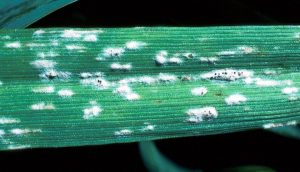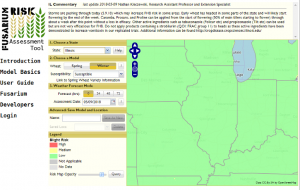Stripe rust is a fungal disease of wheat that can be extremely damaging under the appropriate conditions. Unlike stem and leaf rust, stripe rust is a cool season beast, favoring temperatures between the mid 50’s-60’s. When temperatures are cool and humid, disease incidence and severity can increase rapidly, reducing yields. Most often, stripe rust has to blow into Illinois from southern regions each year. The earlier the disease arrives, the more potential it has to reduce yields; however, under the appropriate conditions significant yield impacts can be observed even when the disease arrives late in the development of the crop. I have had fungicide trials where stripe rust onset occurred near heading, and wet cool conditions favored continued development of disease on the crop. In this case, yield reduction was nearly 20 bu / A (Figure below). Now this was a perfect storm, granted, but it does point to the potential the disease has to reduce yields and why we need to keep an eye out for it.
This season we have reported a handful of counties with stripe rust in Southern Illinois. In terms of incidence and severity, both have been very low where the disease was observed. Furthermore, plants in affected fields were near flowering, and fungicide applications for Fusarium head blight also are effective on stripe rust (see figure below). Even though it is cool and up until the last few days, has been rainy, I do not expect this disease to build to problematic levels. However, wheat in the central and northern parts of the state has yet to flower. Producers in these areas should continue to scout fields and consult weather forecasts. Given the low levels of this disease in the south, the likelihood of stripe rust becoming problematic in the central and northern parts of the state is likely fairly low.
The stripe rust map can be found by clicking here. If you are in Illinois and find stripe rust, please send me an email and we can confirm it and add it to the map. This is the first year using this platform, and hopefully more will use it in the future, helping us to monitor stripe rust movement and development over the course of the growing season.



